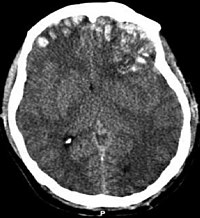
Photo from wikipedia
Introduction/Background Previous studies shown that mechanical factors can be valuable biomarkers to help as a diagnostic aid, risk indicator of osteoarthritis (OA) progression and to be useful in guiding and… Click to show full abstract
Introduction/Background Previous studies shown that mechanical factors can be valuable biomarkers to help as a diagnostic aid, risk indicator of osteoarthritis (OA) progression and to be useful in guiding and monitoring treatments. Since the relationship between radiographic Kellgren-Lawrence (KL) grades and knee biomechanics and is not well understood, the study aims at assessing how knee kinematics differ with increasing KL grade. Material and method This cross-sectional study was carried out in Quebec, Canada primary care clinics. Knee OA patients with KL grade ≥ 2 and with pain ≥ 4/10 were recruited. Sociodemographic characteristics and KOOS were compiled. In-clinic 3D knee kinematics was analyzed using the KneeKG™ system. ANCOVAs were performed on 11 kinematic parameters with age as a covariate due to statistical difference between KL4 and KL2 group. A Bonferroni correction was also applied (α = 0.05/11 = 0.005). Results Two hundred and ninety-four knee OA patients from 62 clinics participated in the study (62.2% women, mean age 63 ± 9.2) ( Table 1 ). KL grade of the most painful knee was equally distributed (34.4% KL2, 35.7% KL3 and 29.9 KL4). Half of participants had bilateral knee OA (52.0%), therefore, kinematic parameters was evaluated on 437 knees. Worst condition of KL4 group was confirmed by KOOS scores ( Table 2 ). Flexion-extension motion during gait was significantly reduced, translating in a more stiff gait pattern, as KL grade increased. KL4 group also exhibited a strongly accentuated dynamic varus alignment and thrust during gait ( Table 3 ). Conclusion Results show that knee function/kinematics of knee OA patients differ with increasing KL grade severity. This reinforces the value adding a functional assessment in the knee OA episode of care to personalize conservative treatment strategy as the progression of OA evolves.
Journal Title: Annals of Physical and Rehabilitation Medicine
Year Published: 2018
Link to full text (if available)
Share on Social Media: Sign Up to like & get
recommendations!